sensor MITSUBISHI ECLIPSE CROSS 2018 (in English) Owner's Guide
[x] Cancel search | Manufacturer: MITSUBISHI, Model Year: 2018, Model line: ECLIPSE CROSS, Model: MITSUBISHI ECLIPSE CROSS 2018Pages: 417, PDF Size: 74.06 MB
Page 197 of 417
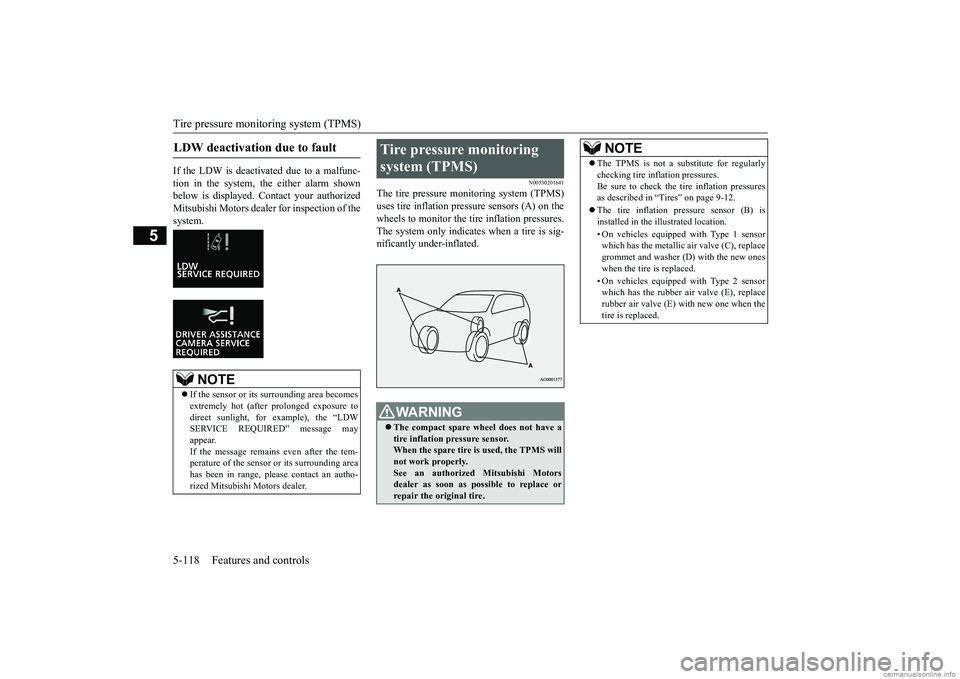
Tire pressure monitoring system (TPMS) 5-118 Features and controls
5
If the LDW is deactivated due to a malfunc- tion in the system, the either alarm shown below is displayed. Contact your authorizedMitsubishi Motors dealer for inspection of the system.
N00530201641
The tire pressure monitoring system (TPMS) uses tire inflation pressure sensors (A) on thewheels to monitor the tire inflation pressures. The system only indicates when a tire is sig- nificantly under-inflated.
LDW deactivation due to fault
NOTE
If the sensor or its surrounding area becomes extremely hot (after prolonged exposure to direct sunlight, for example), the “LDW SERVICE REQUIRED” message mayappear. If the message remains even after the tem- perature of the sensor or its surrounding areahas been in range, please contact an autho- rized Mitsubishi Motors dealer.
Tire pressure monitoring system (TPMS)
WA R N I N G The compact spare wheel does not have a tire inflation pressure sensor. When the spare tire is
used, the TPMS will
not work properly. See an authorized Mitsubishi Motors dealer as soon as possible to replace orrepair the original tire.
NOTE
The TPMS is not a substitute for regularly checking tire inflation pressures. Be sure to check the tire inflation pressures as described in “Tires” on page 9-12. The tire inflation pressure sensor (B) is installed in the illustrated location. • On vehicles equipped with Type 1 sensor which has the metallic air valve (C), replace grommet and washer (D) with the new oneswhen the tire is replaced. • On vehicles equipped with Type 2 sensor which has the rubber air valve (E), replace rubber air valve (E) with new one when the tire is replaced.
BK0252700US.book
118 ページ 2017年10月4日 水曜日 午後4時54分
Page 199 of 417
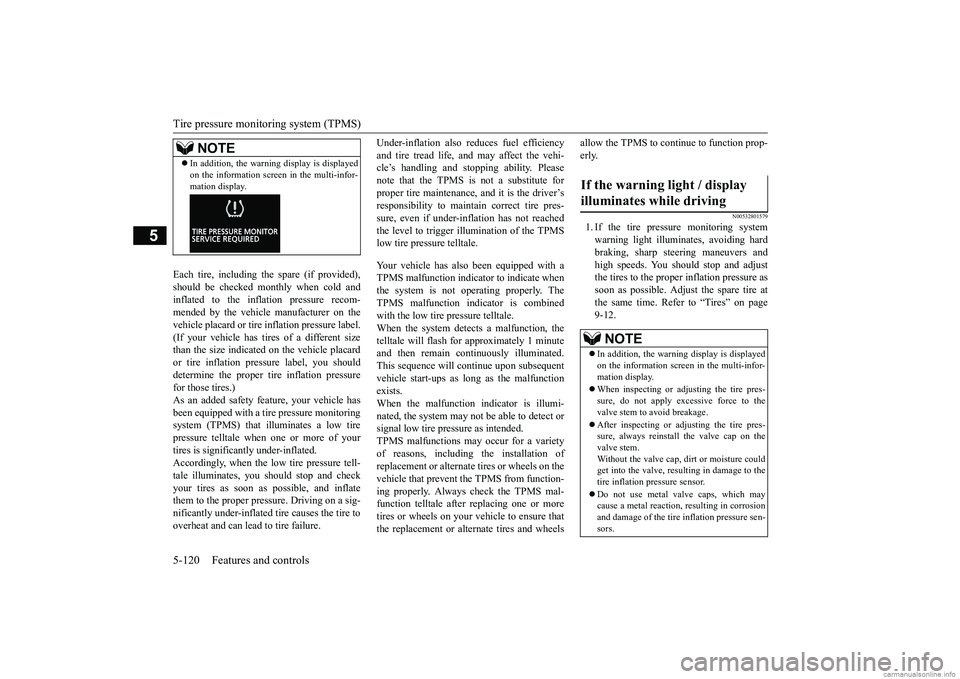
Tire pressure monitoring system (TPMS) 5-120 Features and controls
5
Each tire, including the spare (if provided), should be checked monthly when cold andinflated to the inflation pressure recom- mended by the vehicle manufacturer on the vehicle placard or tire inflation pressure label.(If your vehicle has tires of a different size than the size indicated on the vehicle placard or tire inflation pressure label, you shoulddetermine the proper tire inflation pressure for those tires.) As an added safety feature, your vehicle hasbeen equipped with a tire pressure monitoring system (TPMS) that illuminates a low tire pressure telltale when one or more of yourtires is significantly under-inflated. Accordingly, when the low tire pressure tell- tale illuminates, you should stop and checkyour tires as soon as possible, and inflate them to the proper pressure. Driving on a sig- nificantly under-inflated tire causes the tire tooverheat and can lead to tire failure.
Under-inflation also reduces fuel efficiency and tire tread life, and may affect the vehi- cle’s handling and stopping ability. Please note that the TPMS is not a substitute forproper tire maintenance, and it is the driver’s responsibility to maintain correct tire pres- sure, even if under-inflation has not reachedthe level to trigger illumination of the TPMS low tire pressure telltale. Your vehicle has also been equipped with a TPMS malfunction indicator to indicate whenthe system is not operating properly. TheTPMS malfunction indicator is combined with the low tire pressure telltale. When the system detects a malfunction, thetelltale will flash for approximately 1 minute and then remain continuously illuminated. This sequence will continue upon subsequentvehicle start-ups as long as the malfunction exists. When the malfunction indicator is illumi-nated, the system may not be able to detect or signal low tire pressure as intended. TPMS malfunctions may occur for a varietyof reasons, including the installation of replacement or alternate tires or wheels on the vehicle that prevent the TPMS from function-ing properly. Always check the TPMS mal- function telltale after replacing one or more tires or wheels on your vehicle to ensure thatthe replacement or alternate tires and wheels
allow the TPMS to continue to function prop- erly.
N00532801579
1. If the tire pressure monitoring system warning light illuminates, avoiding hard braking, sharp steering maneuvers andhigh speeds. You should stop and adjustthe tires to the proper inflation pressure as soon as possible. Adjust the spare tire at the same time. Refer to “Tires” on page9-12.
NOTE
In addition, the warning display is displayed on the information screen in the multi-infor- mation display.
If the warning light / display illuminates while driving
NOTE
In addition, the warning display is displayed on the information screen in the multi-infor- mation display. When inspecting or adjusting the tire pres- sure, do not apply excessive force to thevalve stem to avoid breakage. After inspecting or adjusting the tire pres- sure, always reinstall the valve cap on the valve stem. Without the valve cap, dirt or moisture could get into the valve, resulting in damage to the tire inflation pressure sensor. Do not use metal valve caps, which may cause a metal reaction, resulting in corrosionand damage of the tire inflation pressure sen- sors.
BK0252700US.book
120 ページ 2017年10月4日 水曜日 午後4時54分
Page 200 of 417
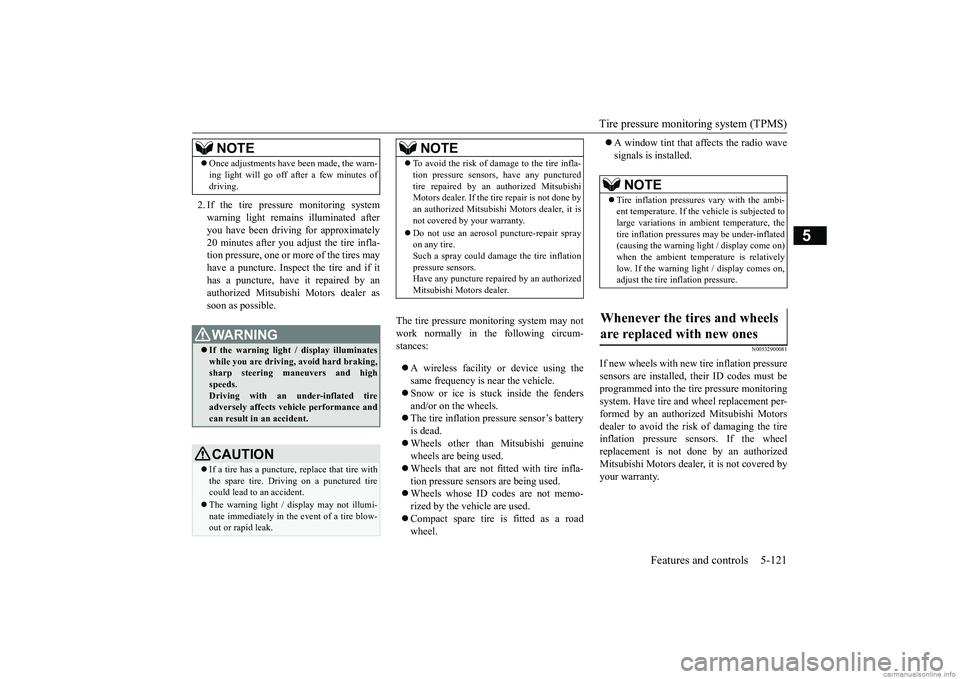
Tire pressure monitoring system (TPMS)
Features and controls 5-121
5
2. If the tire pressure monitoring system warning light remains illuminated after you have been driving for approximately20 minutes after you adjust the tire infla- tion pressure, one or more of the tires may have a puncture. Inspect the tire and if ithas a puncture, have it repaired by anauthorized Mitsubishi Motors dealer as soon as possible.
The tire pressure monitoring system may not work normally in the following circum-stances: A wireless facility or device using the same frequency is near the vehicle. Snow or ice is stuck inside the fenders and/or on the wheels. The tire inflation pressure sensor’s battery is dead. Wheels other than Mitsubishi genuine wheels are being used. Wheels that are not fitted with tire infla- tion pressure sensors are being used. Wheels whose ID co
des are not memo-
rized by the vehicle are used. Compact spare tire is fitted as a road wheel.
A window tint that affects the radio wave signals is installed.
N00532900081
If new wheels with new tire inflation pressuresensors are installed, their ID codes must beprogrammed into the tire pressure monitoring system. Have tire and wheel replacement per- formed by an authorized Mitsubishi Motorsdealer to avoid the risk of damaging the tire inflation pressure sensors. If the wheel replacement is not done by an authorizedMitsubishi Motors dealer, it is not covered by your warranty.
Once adjustments have been made, the warn- ing light will go off after a few minutes of driving.WA R N I N G If the warning light / display illuminates while you are driving, avoid hard braking,sharp steering maneuvers and high speeds. Driving with an under-inflated tireadversely affects vehicle performance and can result in an accident.CAUTION If a tire has a puncture, replace that tire with the spare tire. Driving on a punctured tire could lead to an accident. The warning light / display may not illumi- nate immediately in the event of a tire blow-out or rapid leak.NOTE
NOTE
To avoid the risk of damage to the tire infla- tion pressure sensors, have any punctured tire repaired by an authorized Mitsubishi Motors dealer. If the tire repair is not done by an authorized Mitsubishi Motors dealer, it isnot covered by your warranty. Do not use an aerosol puncture-repair spray on any tire. Such a spray could damage the tire inflation pressure sensors.Have any puncture repaired by an authorized Mitsubishi Motors dealer.
NOTE
Tire inflation pressures vary with the ambi- ent temperature. If the vehicle is subjected to large variations in ambient temperature, thetire inflation pressures may be under-inflated (causing the warning light / display come on) when the ambient temperature is relativelylow. If the warning light / display comes on, adjust the tire inflation pressure.
Whenever the tires and wheels are replaced with new ones
BK0252700US.book
121 ページ 2017年10月4日 水曜日 午後4時54分
Page 201 of 417
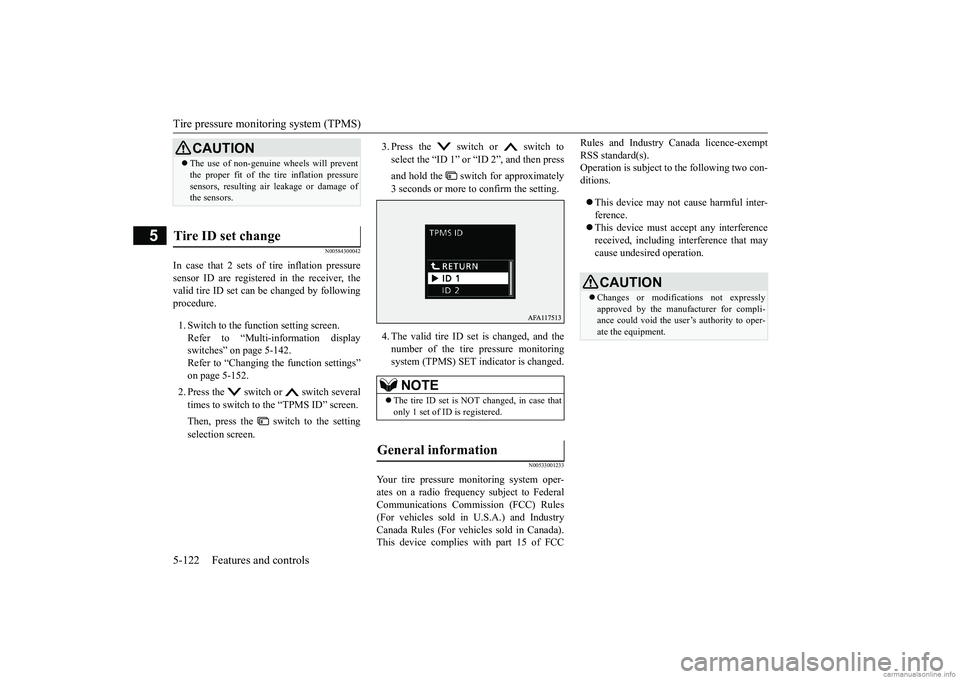
Tire pressure monitoring system (TPMS) 5-122 Features and controls
5
N00584300042
In case that 2 sets of tire inflation pressure sensor ID are registered in the receiver, the valid tire ID set can be changed by followingprocedure. 1. Switch to the function setting screen. Refer to “Multi-information display switches” on page 5-142.Refer to “Changing the function settings” on page 5-152. 2. Press the switch or switch several times to switch to the “TPMS ID” screen. Then, press the switch to the setting selection screen.
3. Press the switch or switch to select the “ID 1” or “ID 2”, and then press and hold the switch for approximately 3 seconds or more to confirm the setting. 4. The valid tire ID set is changed, and the number of the tire pressure monitoringsystem (TPMS) SET indicator is changed.
N00533001233
Your tire pressure monitoring system oper- ates on a radio frequency subject to Federal Communications Commission (FCC) Rules(For vehicles sold in U.S.A.) and Industry Canada Rules (For vehicles sold in Canada). This device complies with part 15 of FCC
Rules and Industry Canada licence-exempt RSS standard(s). Operation is subject to the following two con- ditions. This device may not cause harmful inter- ference. This device must accept any interference received, including interference that maycause undesired operation.
CAUTION The use of non-genuine wheels will prevent the proper fit of the tire inflation pressure sensors, resulting air leakage or damage of the sensors.
Tire ID set change
NOTE
The tire ID set is NOT changed, in case that only 1 set of ID is registered.
General information
CAUTION Changes or modifications not expressly approved by the manufacturer for compli- ance could void the user’s authority to oper-ate the equipment.
BK0252700US.book
122 ページ 2017年10月4日 水曜日 午後4時54分
Page 202 of 417
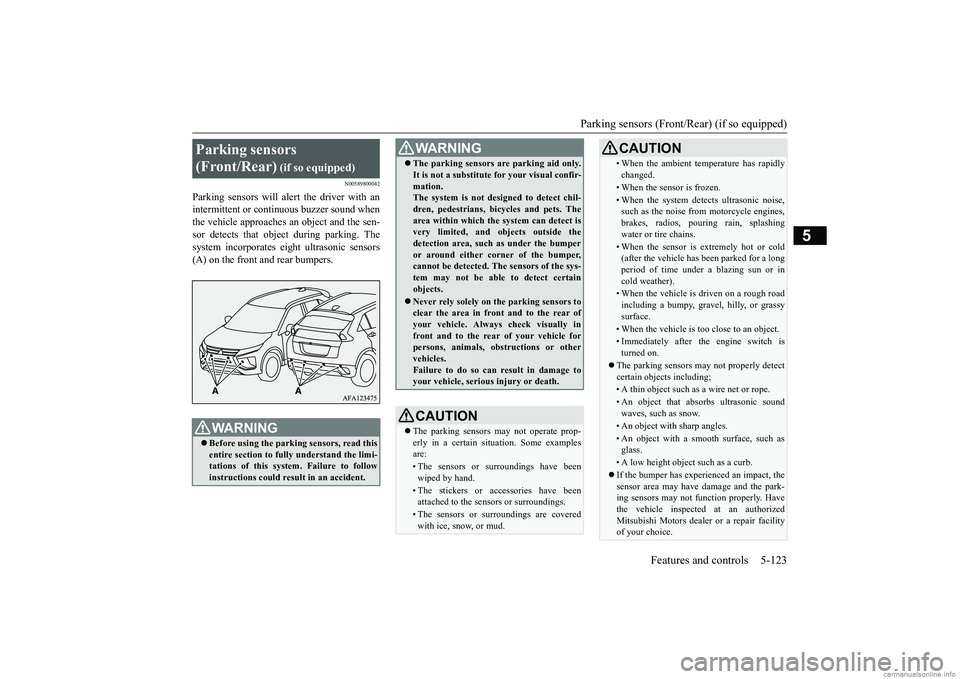
Parking sensors (Front/Rear) (if so equipped)
Features and controls 5-123
5
N00589800042
Parking sensors will alert the driver with an intermittent or continuous buzzer sound whenthe vehicle approaches an object and the sen- sor detects that object during parking. The system incorporates eight ultrasonic sensors(A) on the front and rear bumpers.Parking sensors (Front/Rear)
(if so equipped)
WA R N I N G Before using the parking sensors, read this entire section to fully understand the limi-tations of this system. Failure to follow instructions could result in an accident.
The parking sensors are parking aid only. It is not a substitute for your visual confir- mation. The system is not designed to detect chil- dren, pedestrians, bicycles and pets. Thearea within which the system can detect is very limited, and ob
jects outside the
detection area, such as under the bumperor around either corner of the bumper, cannot be detected. The sensors of the sys- tem may not be able to detect certainobjects. Never rely solely on the parking sensors to clear the area in front and to the rear of your vehicle. Always check visually in front and to the rear of your vehicle forpersons, animals, obstructions or other vehicles. Failure to do so can result in damage toyour vehicle, serious injury or death.CAUTION The parking sensors may not operate prop- erly in a certain situation. Some examples are:• The sensors or surroundings have beenwiped by hand.• The stickers or accessories have beenattached to the sensors or surroundings.• The sensors or surroundings are coveredwith ice, snow, or mud.WA R N I N G
• When the ambient temperature has rapidly changed.• When the sensor is frozen.• When the system detects ultrasonic noise,such as the noise from motorcycle engines, brakes, radios, pouring rain, splashingwater or tire chains.• When the sensor is extremely hot or cold(after the vehicle has been parked for a long period of time under a blazing sun or in cold weather).• When the vehicle is driven on a rough roadincluding a bumpy, gravel, hilly, or grassysurface.• When the vehicle is too close to an object.• Immediately after the engine switch isturned on.
The parking sensors may not properly detect certain objects including;• A thin object such as a wire net or rope.• An object that absorbs ultrasonic sound waves, such as snow.• An object with sharp angles.• An object with a smooth surface, such as glass.• A low height object such as a curb. If the bumper has experienced an impact, the sensor area may have damage and the park- ing sensors may not function properly. Have the vehicle inspected at an authorizedMitsubishi Motors dealer or a repair facility of your choice.CAUTION
BK0252700US.book
123 ページ 2017年10月4日 水曜日 午後4時54分
Page 203 of 417
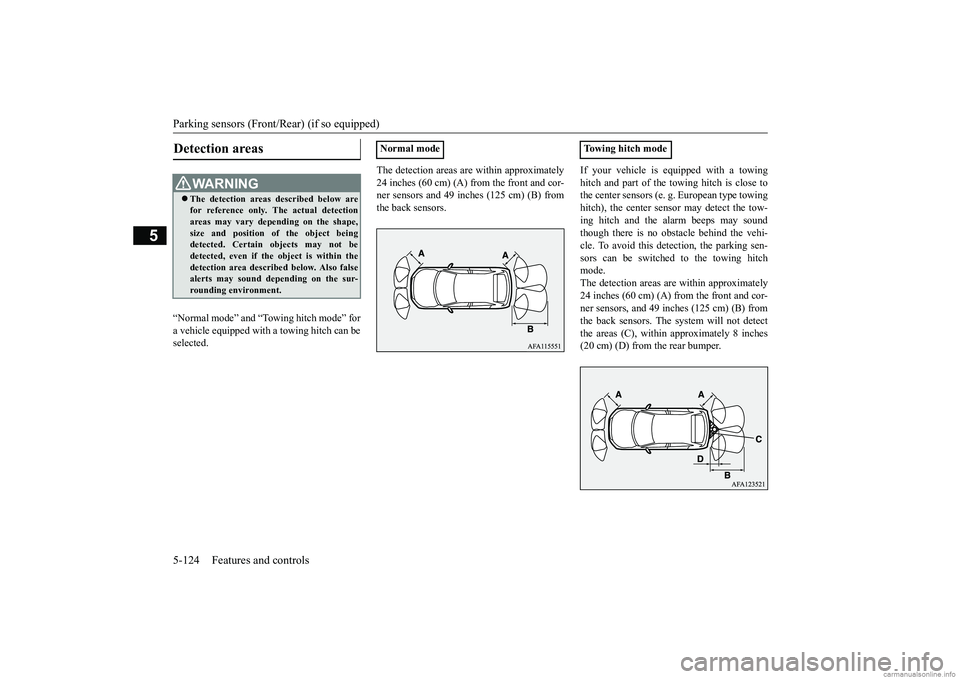
Parking sensors (Front/Rear) (if so equipped) 5-124 Features and controls
5
“Normal mode” and “Towing hitch mode” for a vehicle equipped with a towing hitch can be selected.
The detection areas are within approximately 24 inches (60 cm) (A) from the front and cor- ner sensors and 49 inches (125 cm) (B) from the back sensors.
If your vehicle is equipped with a towing hitch and part of the towing hitch is close to the center sensors (e. g. European type towing hitch), the center sensor may detect the tow-ing hitch and the alarm beeps may sound though there is no obstacle behind the vehi- cle. To avoid this detection, the parking sen-sors can be switched to the towing hitch mode. The detection areas are within approximately24 inches (60 cm) (A) from the front and cor-ner sensors, and 49 inches (125 cm) (B) from the back sensors. The system will not detect the areas (C), within approximately 8 inches(20 cm) (D) from the rear bumper.
Detection areas
WA R N I N G The detection areas described below are for reference only. The actual detection areas may vary depending on the shape, size and position of the object beingdetected. Certain objects may not be detected, even if the object is within the detection area described below. Also falsealerts may sound depending on the sur- rounding environment.
Normal mode
Towing hitch mode
BK0252700US.book
124 ページ 2017年10月4日 水曜日 午後4時54分
Page 204 of 417
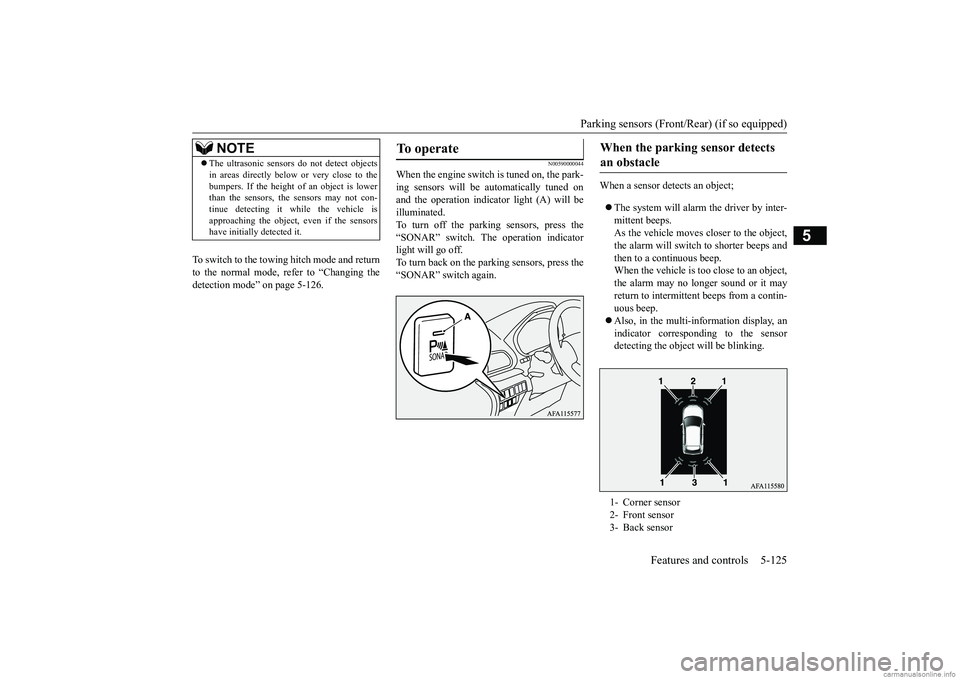
Parking sensors (Front/Rear) (if so equipped)
Features and controls 5-125
5
To switch to the towing hitch mode and return to the normal mode, refer to “Changing the detection mode” on page 5-126.
N00590000044
When the engine switch is tuned on, the park- ing sensors will be automatically tuned onand the operation indi
cator light (A) will be
illuminated. To turn off the parking sensors, press the“SONAR” switch. The operation indicator light will go off. To turn back on the parking sensors, press the“SONAR” switch again.
When a sensor detects an object; The system will alarm the driver by inter- mittent beeps. As the vehicle moves closer to the object, the alarm will switch to shorter beeps andthen to a continuous beep. When the vehicle is too close to an object, the alarm may no longer sound or it mayreturn to intermittent beeps from a contin-uous beep. Also, in the multi-information display, an indicator corresponding to the sensordetecting the object will be blinking.
NOTE
The ultrasonic sensors do not detect objects in areas directly below or very close to the bumpers. If the height of an object is lower than the sensors, the sensors may not con- tinue detecting it while the vehicle isapproaching the object,
even if the sensors
have initially detected it.
To operate
When the parking sensor detects an obstacle
1- Corner sensor 2- Front sensor 3- Back sensor
BK0252700US.book
125 ページ 2017年10月4日 水曜日 午後4時54分
Page 205 of 417
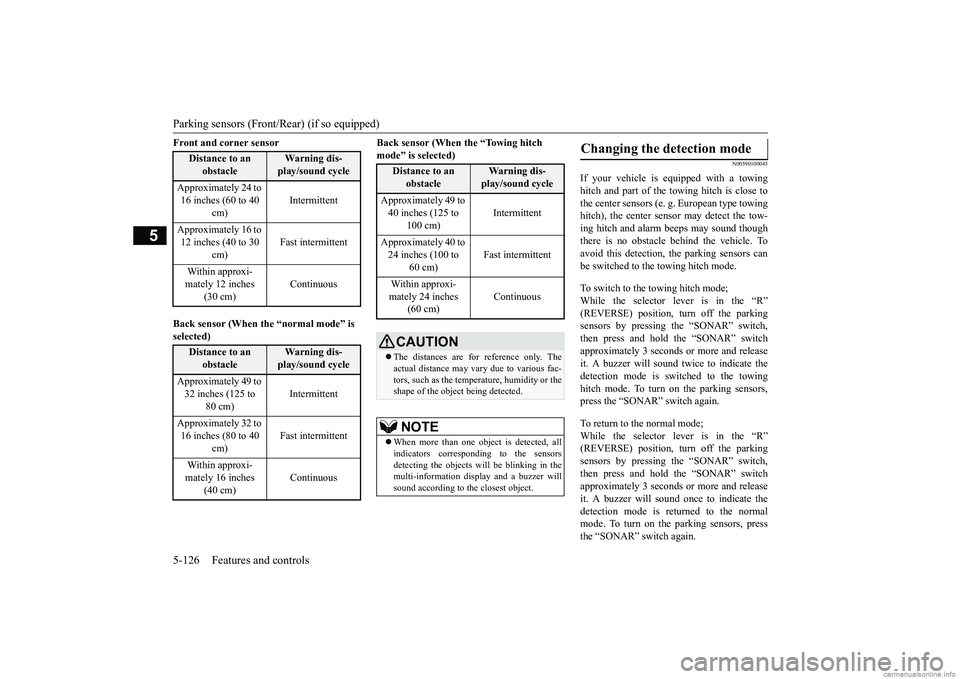
Parking sensors (Front/Rear) (if so equipped) 5-126 Features and controls
5
Front and corner sensor Back sensor (When the “normal mode” is selected)
Back sensor (When the “Towing hitch mode” is selected)
N00590100045
If your vehicle is equipped with a towinghitch and part of the towing hitch is close tothe center sensors (e. g. European type towing hitch), the center sensor may detect the tow- ing hitch and alarm beeps may sound thoughthere is no obstacle behind the vehicle. To avoid this detection, the parking sensors can be switched to the towing hitch mode. To switch to the towing hitch mode; While the selector lever is in the “R”(REVERSE) position, turn off the parking sensors by pressing the “SONAR” switch, then press and hold the “SONAR” switchapproximately 3 seconds or more and release it. A buzzer will sound twice to indicate the detection mode is switched to the towinghitch mode. To turn on the parking sensors, press the “SONAR” switch again. To return to the normal mode; While the selector lever is in the “R”(REVERSE) position, turn off the parking sensors by pressing the “SONAR” switch, then press and hold the “SONAR” switchapproximately 3 seconds or more and release it. A buzzer will sound once to indicate the detection mode is returned to the normalmode. To turn on the parking sensors, press the “SONAR” switch again.
Distance to an
obstacle
War n i n g d i s -play/sound cycle
Approximately 24 to 16 inches (60 to 40
cm)
Intermittent
Approximately 16 to 12 inches (40 to 30
cm)
Fast intermittent
Within approxi- mately 12 inches
(30 cm)
Continuous
Distance to an
obstacle
War n i n g d i s -play/sound cycle
Approximately 49 to 32 inches (125 to
80 cm)
Intermittent
Approximately 32 to 16 inches (80 to 40
cm)
Fast intermittent
Within approxi- mately 16 inches
(40 cm)
Continuous
Distance to an
obstacle
War n i n g d i s -play/sound cycle
Approximately 49 to 40 inches (125 to
100 cm)
Intermittent
Approximately 40 to 24 inches (100 to
60 cm)
Fast intermittent
Within approxi- mately 24 inches
(60 cm)
Continuous
CAUTION The distances are for reference only. The actual distance may vary due to various fac-tors, such as the temperature, humidity or the shape of the object being detected.NOTE
When more than one object is detected, all indicators corresponding to the sensors detecting the objects will be blinking in the multi-information display and a buzzer willsound according to the closest object.
Changing the detection mode
BK0252700US.book
126 ページ 2017年10月4日 水曜日 午後4時54分
Page 206 of 417
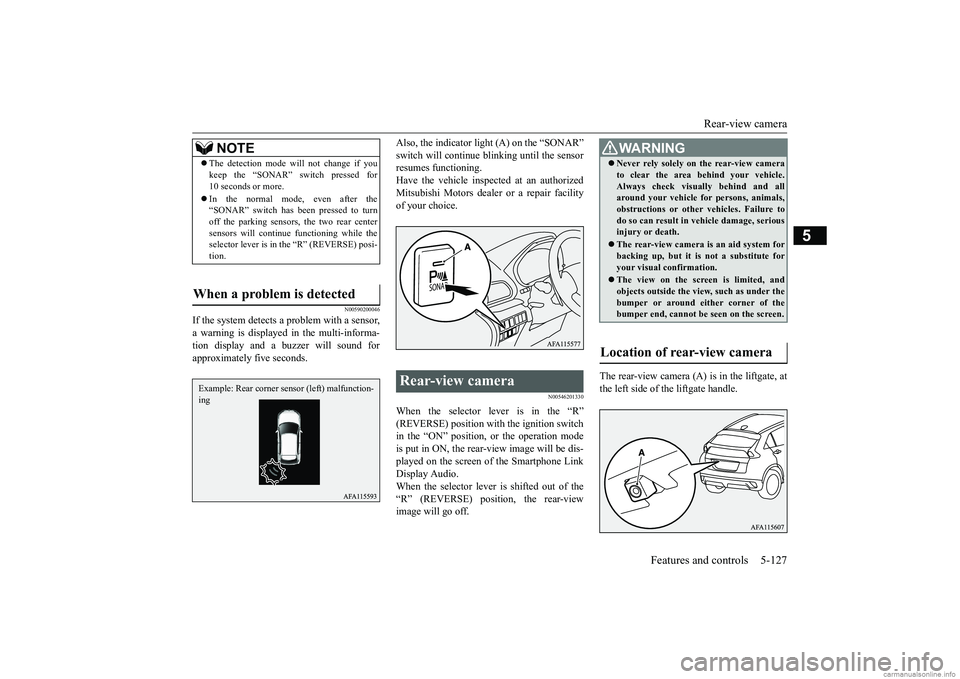
Rear-view camera
Features and controls 5-127
5
N00590200046
If the system detects a problem with a sensor, a warning is displayed in the multi-informa- tion display and a buzzer will sound forapproximately five seconds.
Also, the indicator light (A) on the “SONAR” switch will continue blinking until the sensor resumes functioning. Have the vehicle inspected at an authorizedMitsubishi Motors dealer or a repair facility of your choice.
N00546201330
When the selector lever is in the “R” (REVERSE) position with the ignition switch in the “ON” position, or the operation mode is put in ON, the rear-view image will be dis-played on the screen of the Smartphone Link Display Audio. When the selector lever is shifted out of the“R” (REVERSE) position, the rear-view image will go off.
The rear-view camera (A) is in the liftgate, at the left side of the liftgate handle.
NOTE
The detection mode will not change if you keep the “SONAR” switch pressed for 10 seconds or more. In the normal mode, even after the “SONAR” switch has been pressed to turn off the parking sensors, the two rear center sensors will continue functioning while theselector lever is in the “R” (REVERSE) posi- tion.
When a problem is detected
Example: Rear corner sensor (left) malfunction- ing
Rear-view camera
WA R N I N G Never rely solely on the rear-view camera to clear the area behind your vehicle. Always check visually behind and all around your vehicle for persons, animals, obstructions or other vehicles. Failure todo so can result in vehicle damage, serious injury or death. The rear-view camera is an aid system for backing up, but it is not a substitute for your visual confirmation. The view on the screen is limited, and objects outside the view, such as under thebumper or around either corner of the bumper end, cannot be seen on the screen.
Location of rear-view camera
BK0252700US.book
127 ページ 2017年10月4日 水曜日 午後4時54分
Page 251 of 417
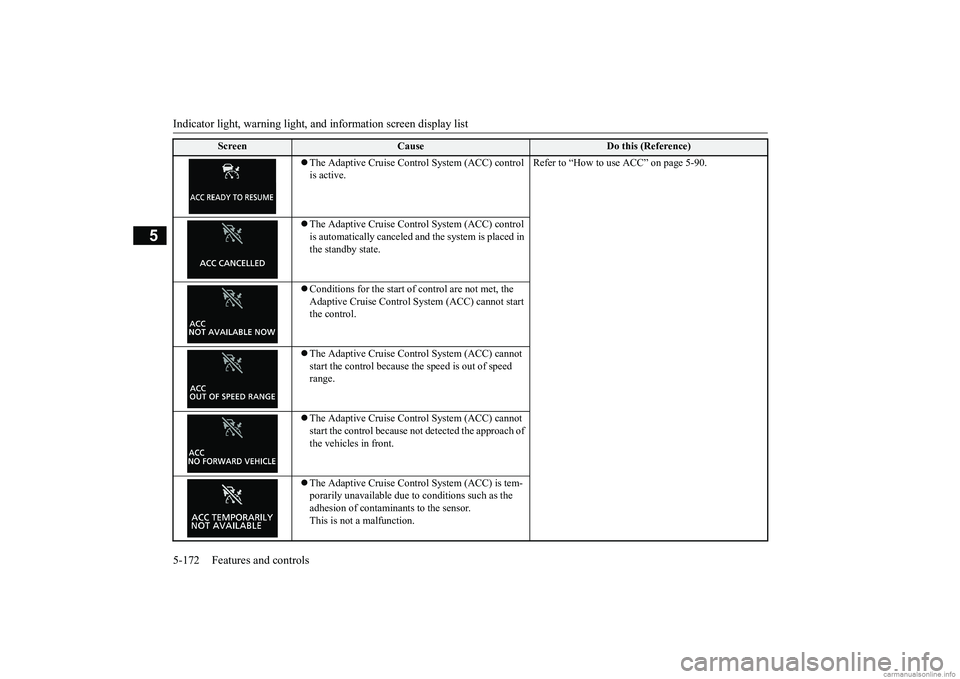
Indicator light, warning light, an
d information screen display list
5-172 Features and controls
5
The Adaptive Cruise Control System (ACC) control is active.
Refer to “How to use ACC” on page 5-90.
The Adaptive Cruise Control System (ACC) control is automatically canceled and the system is placed in the standby state. Conditions for the start of control are not met, the Adaptive Cruise Control System (ACC) cannot start the control. The Adaptive Cruise Control System (ACC) cannot start the control because the speed is out of speed range. The Adaptive Cruise Control System (ACC) cannot start the control because not detected the approach of the vehicles in front. The Adaptive Cruise Control System (ACC) is tem- porarily unavailable due to conditions such as the adhesion of contaminants to the sensor. This is not a malfunction.
Screen
Cause
Do this (Reference)
BK0252700US.book
172 ページ 2017年10月4日 水曜日 午後4時54分